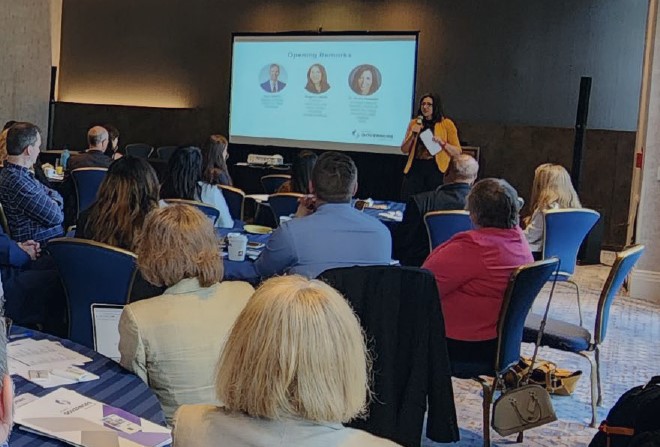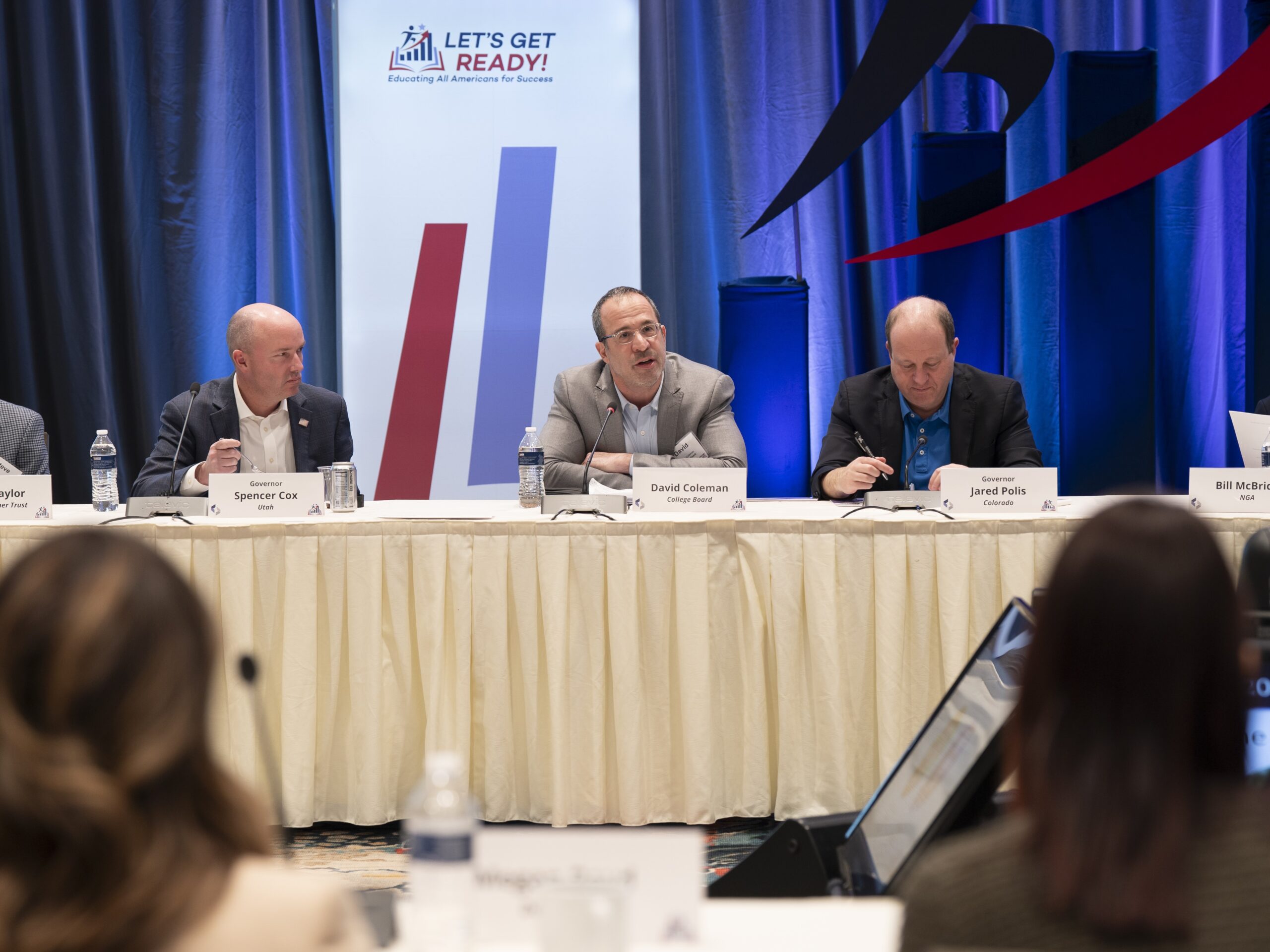As Governors continue to address the consequences of the pandemic, policymakers and state leaders can consider how to strengthen the role of child care as a tool to support maternal, child and whole-family health.
(Download)
This is the third in a series of five publications focused on COVID-19’s impact on maternal and child health (MCH) programs and populations in the U.S. Each publication focuses on a facet of MCH, including COVID-19 response and recovery, health and human services workforce, childcare, behavioral health, and community supports. The information contained in this series comes from a culmination of interviews and research conducted between early 2022 and January 2024, including an expert roundtable held in the Summer of 2022.
The child care industry in the United States, with a billion-dollar valuation, encompasses almost 4 million settings, including home-based and center-based care. Split between provider types, more than 12 million children under 5 are enrolled in child care arrangements. Home-based child care providers (HBCC) and center-based child care (CBCC) providers represent more than 40 percent of child care arrangements, serving 58 percent of working parents with children five years old and younger. Each state has unique quality standards, with high-quality care being more expensive because those providers typically have higher education or more experience, curriculum specifics, health and safety standards, and optimal business practices and children-to-staff ratio. In 34 states, the cost of child care exceeded annual in-state tuition at public universities. While the high cost of child care impacts all families, those with a low income and families of color are less likely to have access to high quality child care.
When enrolled in a high-quality program, attending child care can positively impact development, physical health and school readiness. These programs encourage children to socialize and play with their peers, which is linked to stronger mental health outcomes and readiness to meet the academic and behavioral demands of school. In addition to bolstering a child’s emotional resilience and academic readiness, high quality child care also benefits physical health by limiting screen time and encouraging active or outdoor play. These programs instill healthy habits early, reducing likelihood of long-term health problems associated with obesity in adulthood. Child care providers also offer supports like education on oral health, nutrition and routine immunizations.
Moreover, child care providers can be an avenue for two-generation strategies or programs that support the family as a whole. Access to safe, reliable and quality child care allows parents to work, especially mothers as data indicates that child care instability is more likely to impact a mother’s career than a father’s. According to the Kaiser Family Foundation, more than half of women who quit their jobs during the pandemic cited school or daycare closures as their rationale. Without reliable work and income, parents are more at risk of experiencing negative mental and physical health outcomes.
Governors’ Strategies
The child care industry was upended by the COVID-19 pandemic, with almost 16,000 providers permanently closing between December 2019 and March 2021.3 These closures deny children and their families access to important physical, mental and economic support. As Governors continue to address the consequences of the pandemic, policymakers and state leaders can consider how to strengthen the role of child care as a tool to support maternal, child and whole-family health.
Some strategies include:
- Leveraging existing community relationships and building public-private partnerships to strengthen child care providers’ capacity to combat childhood and family hunger.
- Improving the physical health and development of children by integrating preventative care into child care with innovative partnerships and incentivizing providers to improve the quality of care.
- Providing greater access for parents to affordable, high-quality child care regardless of socioeconomic status or geographic location.
- Elevate programs that support parents as part of the child care ecosystem.
Strengthening Child Care Providers’ Capacity To Combat Childhood And Family Hunger
Child care providers play an important role in the physical health of the children they serve. Children are often fed during these programs, offering an opportunity to offer nutritious food and teach about quality nutrition – contributing to proper growth and development. In addition, child care providers are an important player in the fight to reduce childhood hunger. In 2021, 13 percent of households with children could not afford enough food for the family. Families with a low income were most likely to experience hunger compared to their middle- or high-income peers. Child care providers also detect signs of hunger in the children they serve, with one in four providers reporting concerns of potential food insecurity at home. For some families, the meals provided during child care are the only reliable food sources throughout the day. However, with food costs rising in recent years, child care providers are seeing an increased cost of feeding the children in their care.
The Child and Adult Care Food Program (CACFP) reimburses providers for nutritious meals and snacks for 4.2 million children every day. Most registered CBCC and HBCC providers can receive tiered reimbursement for nutritious food. , Despite being eligible to receive reimbursement, many HBCC do not participate in the CACFP, partially due to a lack of knowledge and barriers to application and compliance. Louisiana took a unique approach to increasing HBCC enrollment in the CACFP as part of their effort to reduce childhood hunger. The states increased HBCC enrollment in CACFP by 20 percent – most states have seen a decline – through adjusting their licensure and registration requirements and using a relationship-based approach to enroll community-based organizations (CBOs). Louisiana offers voluntary registration focused on health, safety and sanitation through the education department. The CACFP is also administered by CBOs that provide oversight and support to HBCCs.
Policy levers to strengthen child care providers’ capacity to address hunger by leveraging existing community relationships and nonprofit support include:
- Directing CACFP agencies to partner with trusted community-based organizations and consider alternative strategies to increase the participation of home-based child care providers in food security programs.
- Building partnerships between local food access initiatives and child care programs to provide families with easy and seamless access to nutritious food.
STATE ACTIONS
In another community-oriented approach, Cabarrus Health Alliance of North Carolina, initiated a partnership between child care providers, food researchers, Meals on Wheels and public health officials, leveraging existing relationships with families to improve access to healthy and affordable food. Partner child care providers offer healthy, low-cost and take-home meals to families at a price point set by the parents. This partnership allowed public health officials to use child care providers as connections to families that could benefit from wraparound food support.
Improving Child Physical Health and Development
The early years of a child’s life are critical – brain and body development can be directly impacted by a child’s positive or negative experiences. State leaders can incentivize child care providers to improve the quality of care and adopt curricula focused on promoting health and protecting well-being by supporting a child’s brain and body development. High-quality child care encourages positive brain development, and enrolled children are more likely to have better academic and relational skills later in life. However, efforts to improve the quality of care may be expensive for providers to pursue, and that cost may be passed down to the families purchasing care; children from families with low incomes are less likely to be enrolled in high-quality care due to the high cost. To offset these costs, states developed programs to subsidize quality improvements. In Maryland, the Child Care Quality Incentive Grant provides facilities up to $2,500 to enhance the quality of care by implementing curriculums that align with the Maryland Kindergarten Readiness and Early Learning Assessment guidelines. These guidelines prioritize activities that encourage motor, physical, and social development.
States can also improve child care quality by implementing or strengthening their licensing standards or Quality Rating Improvement Systems (QRIS), both of which are levers to improve health, well-being, and safety in child care settings. As of January 2023, 11 states use licensing health and safety standards as the foundation for their QRIS systems. In addition to improving development opportunities, when connected with pediatricians in the community, child care providers can serve as a connection to multiple physical health supports for children. In Alabama, the Jefferson County Department of Health (JCDH) partnered with public programs and community-based pediatricians, dentists and social workers, to identify children 18 and under who were considered overdue for a service. This partnership allowed JCDH to leverage existing relationships between Head Start providers and families and aid with scheduling and accessing services.
According to the Urban Institute, the child care sector is struggling to recover from the impact of the COVID-19 pandemic and was still short nationally almost 40,000 workers as of September 2023. To continue to support quality child care in the face of a workforce shortage, states are also leveraging partnerships with child care health consultants (CCHCs) in their efforts to promote physical and emotional health and well-being in early childhood settings. CCHCs are licensed professionals with experience in both early care and community and child health and can help improve healthy practices, train child care staff on health and safety initiatives or connect families to needed medical care. As external subject matter experts, consultants can provide robust technical assistance and implementation support without putting additional burdens on child care staff. The Indiana Department of Family and Social Services operates the Child Care Health Consultant Program that offers free consultation to out-of-home child care providers on issues including child immunizations, mental health, and nutrition.
Similar to CCHCs, infant and early childhood mental health (IECMH) consultants can be embedded into or connected with child care providers to deliver behavioral care to children and families or consult on social-emotional best practices. Developed by the Illinois Children’s Mental Health Partnership, the Illinois Model for Infant and Early Childhood Mental Health Consultation offers comprehensive guidance on IECMH, including standard definitions, consultant competencies, and workforce qualifications. The IECMH consultant training is funded in part by the Preschool Development Grant Birth through Five, and Illinois also incorporates IECMH consultants in home-visiting programs, funded through the federal Maternal, Infant, and Early Childhood Home Visiting (MIECHV) program.
Policy levers to support child physical health and development by integrating preventative care and health promotion into child care with innovative partnerships, and incentivizing providers to improve the quality of care, include:
- Working with state agencies to identify state, federal, or philanthropic funding that can be used to incentivize improvement in the quality of child care.
- Adopting or expanding child care health or infant and early childhood consultant programs to provide guidance and technical assistance to child care providers.
- Creatively braiding federal funding streams, like PDG 0-5, MIECHV, or SAMSHA grants to support innovative pilot projects or improve child care quality.
- Identifying opportunities to allocate additional federal Child Care Development Fund (CCDF) dollars to extend quality supports to more providers or expand the ability of set-aside dollars to support new or home-based child care providers.
- Aligning the state’s Quality Rating Improvement System with health and safety best practices to encourage providers to adopt practices that promote infant and child health and wellbeing.
- Creating working groups with educators, parents, doctors, public health officials and private sector leaders to identify promising practices that support child brain and body development that can be incorporated into child care curriculum.
- Incentivizing and encouraging public-private partnerships between health systems and child care programs to encourage and support child physical health by reducing the administrative burden on families seeking pediatric health care.
STATE ACTIONS
In Missouri, the Mid-America Regional Council Head Start (MARC HS) and physical health provider, Swope, partnered to create KidsCARE. The program supports families by scheduling and issuing reminders for medical, behavioral and dental health care. With KidsCARE’s effort to reduce administrative barriers, the program completed more than 190 wellness care exams and more than 300 dental exams for Head Start families in Missouri.
Through their KIDS NOW Initiative, Kentucky employs health professionals. including registered nurses and health educators, as CCHCs to provide health guidance and technical assistance support to child care providers serving children age 0-5. The Child Care Health Consultation program partners with the Child Care Aware and other state-operated child care programs to offer joint activities for providers and their families.
Championing Innovative Programs that Increase Access to Child Care
Even before the pandemic, families reported having issues accessing affordable, quality child care, with 46 percent reporting more access issues after the COVID-19 pandemic’s start. Communities located in rural areas and those with low-incomes were especially impacted by a lack of child care. For example, it is estimated that a fifth of families in the Western United States lost their child care provider due to the pandemic.
Access to child care is an important element of parental health. Child care allows parents the stability needed to participate in the workforce, which is linked to better health outcomes. In addition, child care access also impacts a parent’s ability to tend to their own health, as a lack of child care can make it difficult for a parent to attend doctor’s appointments. In a 2020 survey of 300 women, 52.7 percent reported foregoing health care due to a lack of child care in the past year.
States can also expand access to child care. In Oklahoma, the Department of Human Services created Kith.care, a program subsidizing non-traditional-hour care where a child receives care from a relative or friend during a time when HBCCs or CBCCs are closed, like overnight. Oklahoma also established Community Hope Centers that co-locate services like health care and workforce training while offering on-site child care to reduce the likelihood that a parent forgoes services. In 2022, New Mexico enacted initiatives to use American Rescue Plan dollars with funds raised from oil and gas production revenue to make child care free for most of its residents. The state also announced $10 million in grant funding to expand access to areas determined to be child care deserts.
States can use existing federal funding streams to bolster child care access. Several states are using the Preschool Development Grant Birth through Five support to increase families’ access to high-quality child care. Through its 2022 renewal grant, Ohio is providing subgrants with the goal of increasing child care access to families with low incomes or in rural communities, and Alaska is pursuing a public awareness campaign to empower parents to make informed decisions about selecting a high-quality child care provider. Mississippi will use its funding from the 2022 renewal grant to create a new Quality Improvement System that prioritizes input from families and providers to ensure that the early childhood system best meets the needs of local families.
Policy levers to develop innovative programs that increase access to child care tailored to needs of each community include:
- Convening stakeholder groups, including providers, employers, and parents with a goal of determining potential options to provide nontraditional hour care to families to reduce the child care burden on parental healthcare.
- Identifying opportunities to maximize the flexibilities within federal funding streams, including Preschool Development Grant dollars.
- Partnering with non-profits and community-based organizations to quantify child care needs from the provider perspective.
- Exploring providing resources to gather data in communities to determine specific needs and solutions for the area.
- Establishing grant programs to support the sustainable development of new providers in child care deserts.
STATE ACTIONS
As part of Iowa Governor Kim Reynold’s Rural Empowerment effort announced in 2021, the Rural Child Care Market Study grant program offered ten rural communities up to $10,000 each to determine their community’s unique child care needs and develop potential solutions through the use of data. The grant is open to state agencies, higher education institutions, and nonprofits with an aim to include rural voices in the expansion of child care access.
The Minnesota Department of Human Services partnered with First Children’s Finance to create the Rural Child Care Innovation Program. The program helps communities in identifying the scope and size of child care challenges and supports the development of community-based solutions. The program has served more than 31 rural communities and created more than 1,000 new child care slots as of 2020.
Elevating Programs that Support Parents as Part of the Child Care Ecosystem
Almost 40 percent of children are cared for by a parent full-time. The percentage of parents staying home with their kids has risen by 60 percent since 2019 – directly correlated to closures during the COVID-19 pandemic. These closures and the overnight adoption of work-from-home structures during the pandemic impacted the way parents care for their children. Historically, mothers were more likely to fill the role of a stay-at-home parent, although stay-at-home father rates have increased by 8 percent since 1989. State leaders are adopting programs that support the evolving needs of parents not just as workers, but as caregivers as well.
Many states, like Missouri and Georgia, offer paid parental leave to public sector employees. Championed by South Carolina Governor Henry McMaster in 2022, recently passed legislation offers up to 6 weeks of paid parental leave for birth or adoption. The program offers various leave time depending on whether the parent is the “primary” or “secondary” caregiver.
Twelve states and the District of Columbia expanded paid family leave programs and passed universal paid leave laws that offer coverage to employees working in the private sector. In addition to guaranteeing family leave coverage for new parents, New Hampshire enacted a program providing paid leave to private sector employers or employees who voluntarily purchase coverage.
Policy levers to elevate programs that support parents as part of the child care ecosystem include:
- Setting an agenda that includes legislation that invests in a paid family leave program for state employees, and collaborating with private sector providers, state agencies, healthcare providers, and community organizations serving families to determine the best way to offer paid leave to families.
- Reducing time and transportation burdens on stay-at-home parents, allowing state agencies to either continue pandemic-era flexibilities or implement new flexibilities that allow for virtual delivery of health and well-being services, including behavioral health care, home-visiting appointments, safe sleep classes, smoking cessation assistance and child passenger safety sessions.
- Directing agencies to provide education to non-clinical providers on legal considerations for telemedicine appointments.
- Advising state child care agencies to integrate and incentivize two-generational strategies in Head Start and Early Head Start programs to build a wraparound system to serve the whole family, like job training or education supports.
Conclusion
The COVID-19 pandemic caused thousands of child care providers to close their doors, some permanently. These closures upended parents, employers and communities while revealing the important role child care plays in a family’s life, especially as it relates to health and well-being. Under the direction of their Governors, child care providers can support strong nutrition, mitigate hunger, encourage child development, act as a conduit for wraparound supports and coordinate health services for families. Governors have an opportunity to take a holistic approach to strengthen access to and the quality of out-of-home child care while supporting programs that recognize and uplift parents as part of a child care ecosystem.
Acknowledgments
The NGA Center would like to thank the state officials and experts who participated in the June 2022 expert roundtable as well as those who provided feedback to inform this publication. The NGA Center would also like to thank the Health Resources and Services Administration in the U.S. Department of Health and Human Services for their generous support of this project. The contents of this publication are solely the responsibility of the authors and do not necessarily represent the official views of HRSA or the U.S. Department of Health and Human Services.
This publication was developed by Jessica Kircher, Michelle LeBlanc, and Brittney Roy at the National Governors Association Center for Best Practices.
Recommended citation: Kirchner, J., LeBlanc, M., & Roy, B. (2024). State Strategies to Address the Impact of COVID-19 on Maternal and Child Populations: Child Care and COVID-19. Washington, D.C.: National Governors Association Center for Best Practices.













